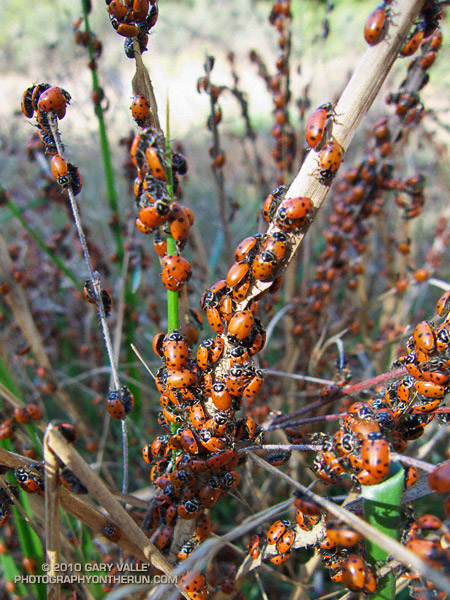
A Winter aggregation of convergent ladybug beetles in the Santa Monica Mountains, near Malibu, California. Here’s a video snapshot of one small cluster of the ladybugs.
From Saturday’s trail run from Kanan Rd. to Malibu Canyon.

A Winter aggregation of convergent ladybug beetles in the Santa Monica Mountains, near Malibu, California. Here’s a video snapshot of one small cluster of the ladybugs.
From Saturday’s trail run from Kanan Rd. to Malibu Canyon.
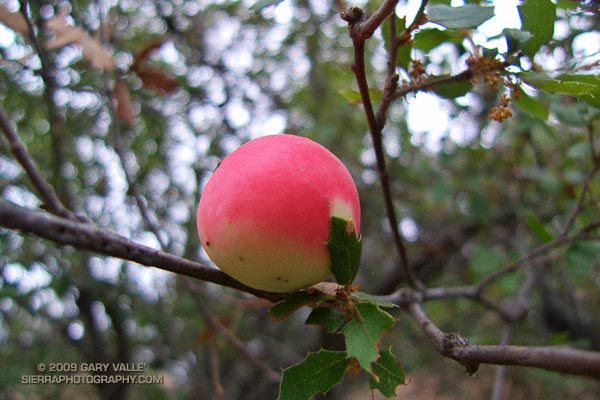
Almost incandescent in the soft light of an overcast sky, the remarkable color of this scrub oak apple gall contrasts sharply with the muted greens, grays and browns of the surrounding chaparral.
The gall forms in response to the larvae of the California gall wasp. The gall protects the developing larvae, as well as providing it a source of food.
On the right side of the gall there appears to be a “sun print” of an oak leaf in the red color, where a nearby leaf may have shielded the surface from sunlight.
From today’s run on the Backbone Trail in the Santa Monica Mountains, near Saddle Peak.
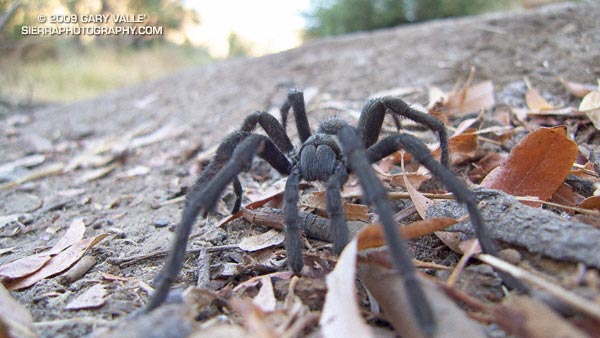
September and October are the months I’m most likely to encounter tarantulas in Upper Las Virgenes Canyon Open Space Preserve (formerly Ahmanson Ranch). Autumn is when maturing male tarantulas emerge from their burrows and wander in search of a mate.
This tarantula (Aphonopelma spp.) was found near upper Las Virgenes Creek on today’s wonderfully cool 8 mile “FiveFingers” run.
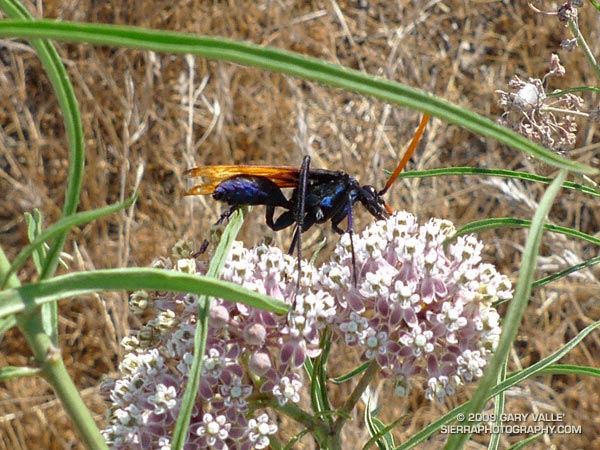
Its menacing body glistening a deep iridescent blue, a tarantula hawk wasp feeds on the flowers of a narrow-leaf milkweed.
I haven’t found these huge wasps to be particularly aggressive, but I’m not sure at what point a digital camera held inches from the alien-looking insect becomes a threat — and I don’t want to find out!
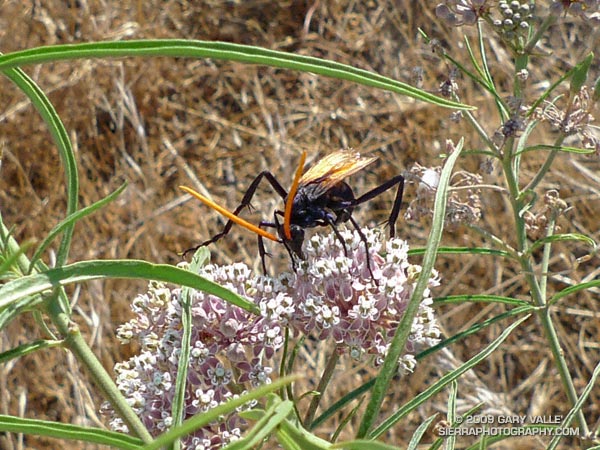
The following is from the paper Venom and the Good Life in Tarantula Hawks (Hymenoptera: Pompilidae): How to Eat, Not be Eaten, and Live Long:
“Tarantula hawks produce large quantities of venom and their stings produce immediate, intense, excruciating short term pain in envenomed humans. Although the instantaneous pain of a tarantula hawk sting is the greatest recorded for any stinging insect, the venom itself lacks meaningful vertebrate toxicity. …the defensive value of stings and venom of these species is based entirely upon pain. This pain confers near absolute protection from vertebrate predators.”
Shudder…
While photographing the wasp, I also took this short video. From a run earlier this week at Sage Ranch Park.
Related post: Tarantula Hawk
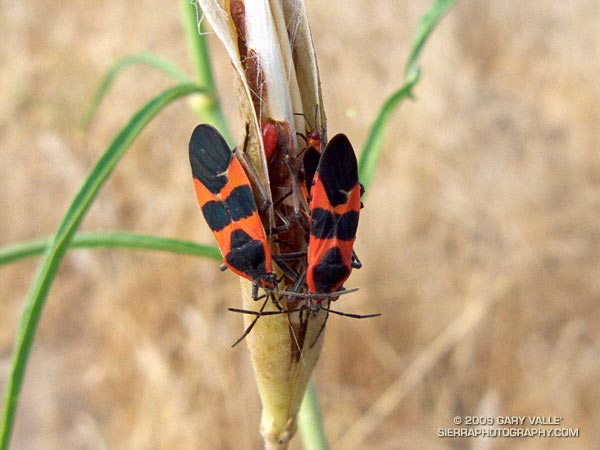
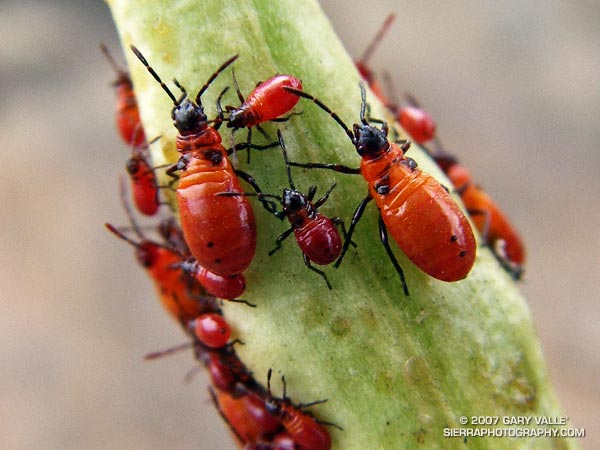
Large milkweed bugs (Oncopeltus fasciatus) on narrow-leaf milkweed. There is a brood of immature bugs (nymphs) in the opening seed pod, between the two adults. The aposematic red-orange color tells predators the insects taste bad. Adults probably benefit from staying on a plant with the nymphs, because collectively the defensive display is more effective.
The adjacent photograph of immature milkweed bugs (from Photography on the Run) is being used by the Denver Museum of Nature and Science as part of their “Awesome Adaptations” station educational program.
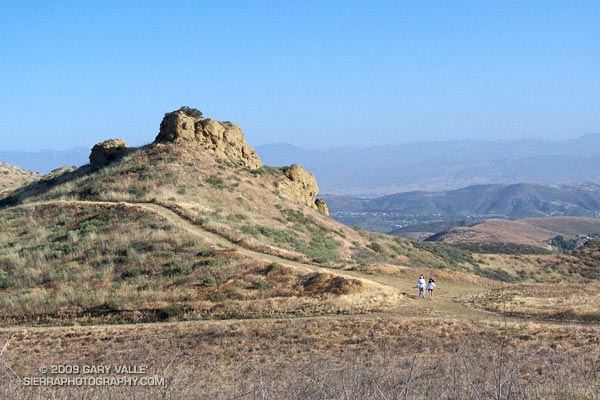
Wood Ranch Open Space
The fire road was covered with crawling and darting bees — so many I could feel the low, resonating buzz of the colony. Standing in the middle of the buzzing bees, I heard an “Oh crap!” from behind me. A mountain biker — stopped about 20 yards away — explains he’s allergic to bee stings.
We were a little east of the China Flat “T” on the Albertson “motorway” — a fire road in the Simi Hills. Taking advantage of cool, sunny weather in the Los Angeles area, I was doing a course I had not done for years, an out and back trail run from the Wood Ranch trailhead to Simi Peak, with a short circuit around China Flat.
I had taken a short detour to check a small vernal pool hidden in the oaks off the fire road. There are surprising number of these ephemeral water sources in the Simi Hills. They sometimes have water when it’s unexpected, but this time the pool was dry.
The bees on the road were digger bees, ground nesting bees that look like fuzzy honeybees. Like honeybees, males have no stinger. Males swarm over the burrows of females, waiting for them to emerge. Females can sting, but in my experience, and from what I’ve read, are generally not aggressive. Here’s a very short video (from later in the run) of a second colony on the Simi Peak Trail.
Not being able to risk being stung, the mountain biker waited on the side of the road for his buddy to realize he wasn’t behind him anymore. I headed back to the China Flat Trail, and then continued to Simi Peak. Here’s a Google Earth image and Cesium browser View of a GPS trace of my approximately 10.75 mile route.
Note: A mountain biker on the Long Canyon trail told me he had seen a mountain lion in the area earlier in the morning. He was certain that it was a mountain lion, and not a bobcat or coyote.